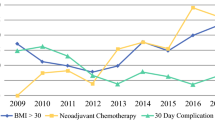Abstract
Background
The potential advantages of tumescent mastectomy technique have been increasingly discussed within the literature. However, there is concern that tumescent solution may also affect postoperative complication rates. This study evaluates patient outcomes following tumescent mastectomy and immediate implant reconstruction.
Methods
Retrospective review of 897 consecutive patients (1,217 breasts) undergoing mastectomy with immediate implant reconstruction between 4/1998 and 10/2008 at a single institution was performed. Demographic and operative factors, postoperative outcomes, and overall follow-up were recorded. Complications were categorized by type and end-outcome. Fisher’s exact test, Student t-test, and multiple linear regression were used for statistical analysis.
Results
Tumescent (n = 332, 457 breasts) and nontumescent (n = 565, 760 breasts) patients were clinically similar. Mean follow-up was 36.5 months. Regression analysis demonstrated that tumescent technique increased the risk of overall complications [odds ratio (OR) 1.36, 95% confidence interval (CI) 1.02–1.81, p = 0.04]. In particular, nonoperative and operative complications (OR 1.53, 95% CI 1.04–2.26, p = 0.04; OR 1.58, 95% CI 1.11–2.23, p = 0.01, respectively), and the rate of major mastectomy flap necrosis (OR 1.57, 95% CI 1.05-2.35, p = 0.03) were significantly affected. In patients with other, more significant risk factors, tumescent technique had an additive effect on complication rates. Additionally, the majority of tumescent breast complications (78.6%, 81/103) had at least one other significant risk factor.
Conclusions
Our review demonstrates that tumescent mastectomy with immediate implant reconstruction, although possessing distinct advantages, can increase postoperative complication rates. This additive effect is particularly apparent in patients with elevated complication risk at baseline. Choice of mastectomy technique should be made with careful consideration of patient comorbidities.
Similar content being viewed by others
References
Pinsolle V, Grinfeder C, Mathoulin-Pelissier S, Faucher A. Complication analysis of 266 immediate breast reconstructions. J Plast Reconstr Aesthet Surg. 2006;59:1017–24.
Davies K, Allan L, Roblin P, Ross D, Farhadi J. Factors affecting post-operative complications following skin-sparing mastectomy with immediate breast reconstruction. Breast. 2011;20:21–25.
Berry T, Brooks S, Sydow N, Djohan R, Nutter B, Lyons J, et al. Complication rates of radiation on tissue expander and autologous breast reconstruction. Ann Surg Oncol. 2010;17:S202–10.
Worland RG. Expanded utilization of the tumescent technique for mastectomy. Plast Reconstr Surg. 1996;98:1321.
Staradub VL, Morrow M. Modified radical mastectomy with knife technique. Arch Surg. 2002;137:105–10.
O’Donoghue JM, Chaubal ND, Haywood RM, Rickard R, Desai SN. An infiltration technique for reduction mammaplasty: results in 192 consecutive breasts. Acta Chir Plast. 1999; 41:103–6.
Soueid A, Nawinne M, Khan H. Randomized clinical trial on the effects of the use of diluted adrenaline solution in reduction mammaplasty: same patient, same technique, same surgeon. Plast Reconstr Surg. 2008;121:30e–33e.
Rosaeg OP, Bell M, Cicutti NJ, Dennehy KC, Lui ACP, Krepski B. Pre-incision infiltration with lidocaine reduces pain and opioid consumption after reduction mammoplasty. Reg Anesth Pain Med. 1998; 23:575–9.
Armour AD, Rotenberg BW, Brown MH. A comparison of two methods of infiltration in breast reduction surgery. Plast Reconstr Surg. 2001;108:343–7.
Metaxotos NG, Asplund O, Hayes M. The efficacy of bupivicaine with adrenaline in reducing pain and bleeding associated with breast reduction: a prospective trial. Br J Plast Surg. 1999;52:290–3.
Habbema L. Breast reduction using liposuction with tumescent local anesthesia and powered cannulas. Dermatol Surg. 2008;35:41–52.
Jabs D, Richards BG, Richards FD. Quantitative effects of tumescent infiltration and bupivicaine injection in decreasing postoperative pain in submuscular breast augmentation. Aesthetic Surg J. 2008; 28:528–3.
Paige KT, Bostwick III J, Bried JT. TRAM flap breast reconstruction: tumescent technique reduces blood loss and transfusion requirement. Plast Reconstr Surg. 2004;113:1645–9.
Carlson GW. Total mastectomy under local anesthesia: the tumescent technique. Breast J. 2005;11:100–2.
Shoher A, Hekier R, Lucci Jr A. Mastectomy performed with scissors following tumescent solution injection. J Surg Oncol. 2003;83:191–3.
Boni R. Tumescent power liposuction in the treatment of the enlarged male breast. Dermatology. 2006;213:140–3.
Porter K, O’Connor S, Rimm E, Lopez M. Electrocautery as a factor in seroma formation following mastectomy. Am J Surg. 1998;176:8–11.
Miller E, Paull DE, Morrissey K, Cortese A, Nowak E. Scalpel versus electrocautery in modified radical mastectomy. Am Surg. 1988;54:284–6.
Kurtz S, Frost D. A comparison of two surgical techniques for performing mastectomy. Eur J Surg Oncol. 1995;21:143–5.
Chun YS, Verma K, Rosen H, et al. Use of tumescent mastectomy technique as a risk factor for native breast skin flap necrosis following immediate breast reconstruction. Am J Surg. 2011;201:160–5.
Black D, Golshan M, Christian R, et al. Post-operative outcomes of mastectomy with breast tumescence infiltration. Presented at: 29th San Antonio Breast Conference; December 2006.
Larson DL, Basir Z, Bruce T. Is oncologic safety compatible with a predictably viable mastectomy skin flap? Plast Reconstr Surg. 2011; 127:27–33.
Conflict of interest
We have no commercial interests or financial support to disclose.
Author information
Authors and Affiliations
Corresponding author
Rights and permissions
About this article
Cite this article
Seth, A.K., Hirsch, E.M., Fine, N.A. et al. Additive Risk of Tumescent Technique in Patients Undergoing Mastectomy with Immediate Reconstruction. Ann Surg Oncol 18, 3041–3046 (2011). https://doi.org/10.1245/s10434-011-1913-y
Received:
Published:
Issue Date:
DOI: https://doi.org/10.1245/s10434-011-1913-y




